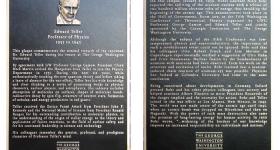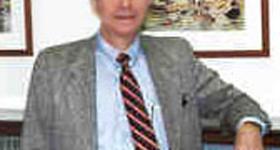Hans Bode, BS ’60, received a PhD in biophysics at Yale and spent four years as a post-doc in Germany learning about the developmental biology of hydra. He continued this...


For more than a century, the Department of Physics has attracted some of the nation's top scholars. Students build a strong foundation in nuclear physics, astrophysics and biophysics while studying advanced concepts, from quantum mechanics to optics. They also collaborate with faculty and partner institutions to understand the building blocks of life, observe exploding stars in distant galaxies and detect subatomic particles at the core of matter.
Study in the physical sciences at the George Washington University goes back to the founding of the Columbian College in 1821. Officially founded in 1912, the department has been a leader in scientific breakthroughs ever since, including hosting the historical 1939 conference at which Nobel Prize Winner Niels Bohr announced that Otto Hahn had successfully split the atom, thus ushering in the atomic age. Department faculty have included renowned scientists such as George Gamow, early developer and advocate of the big bang theory, and Edward Teller, famed for his work on the hydrogen bomb.
Today, the department carries on the practice of excellent research at state-of-the-art labs in Corcoran Hall and Science and Engineering Hall on GW's Foggy Bottom Campus. Faculty regularly secure competitive grants from the U.S. Department of Energy, the National Science Foundation, NASA and the U.S. Naval Research Laboratory. In the lab and in the classroom, the department is applying physics solutions to everyday life.
“GW has a diverse population. The student body comes from very different backgrounds. Even if your idea of fun is running computer modeling cell movement simulations, here you can find your tribe.”
George Sangiolo
BS '18, Biophysics

Hans Bode, BS ’60, received a PhD in biophysics at Yale and spent four years as a post-doc in Germany learning about the developmental biology of hydra. He continued this...
John Capone, BS ’10, is currently enrolled at the University of Maryland, College Park, since 2010. John received his MS in astronomy in 2012 and expects to complete his PhD in...
Phil Brinkman, MA ’74: I have worked for the U.S. Department of Transportation since 1973, first for the Federal Highway Administration leading research efforts to develop...
Steve Howell Receives 2014 Craig Futterman Prize
April 2014. Steve Howell received the Craig Futterman Prize for Outstanding Biophysics Graduate Student. Congratulations Steve!
Nature Publication by Professor Peng
New publication in Nature by Professor Peng
PfSETvs methylation of histone H3K36 represses virulence genes in Plasmodium falciparum. Lubin Jiang...

In 2003, two bronze plaques were mounted at the entrance of the chemistry and physics building, Corcoran Hall. The plaques were commissioned by then GW President Stephen Trachtenberg to show more...
Johee Chung, BS '13 will pursue her Master’s in Education through the Match Corps Residency Program in Boston this fall.
James Kelly, BS '13 will be...
Physics Students Expand Collaborations in China
Prof. Zeng’s group (Prof. Zeng, Dr. Yunjie Zhao and Chenghang Du) visited the Prof. Xiao’s Lab (Huazhong University of Science and Technology, Wuhan) and Prof. Wang’ Lab (Nanjing University,...
Professor Guanyu Wang is Starting a New Laboratory
Professor Guanyu Wang is starting a new laboratory in September 2013 with both biological experiments and high performance computation as integral components (3/2013).

